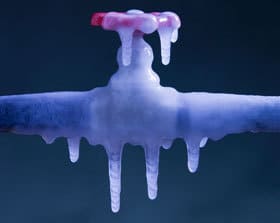Above all, avoiding frozen pipes is always the main goal for any plumbing/winterization situation if at all possible. Many easy to follow steps can be taken early on to avoid the chance of having any pipes become frozen and eventually cracked. If winterization is done early enough and correctly, you should be in the clear for the entirety of any winter or freezing temperature period. Unfortunately, accidents and improper winterizations can happen, which lead to a pipe becoming partially or completely frozen before you can reverse the situation. There are many different possibilities and specific circumstance involving pipes that have ultimately succumbed to the freezing temperatures. Knowledge and caution must be applied whenever dealing with this type of situation. Let’s examine three important aspects when approaching any kind of frozen pipe.
Safety First
First off and always the most important aspect is understanding the severity and potential risks of attempting to solve the problem without a professional. When the water inside of a pipe becomes frozen and solid, the pressure is vastly increased since water expands and pushes outward when it freezes. This buildup of pressure can lead to explosions and pipes breaking violently if thawed incorrectly. If you are in anyway unsure as to which pipe is frozen, how badly it is frozen, or how to approach the situation, call a professional that specializes in DC commercial pipe thawing services. This may seem like a more expensive route, but it will not only ensure your safety, it will also prevent further accidental damage to your problem area and plumbing in general.
Locating And Opening A Frozen Pipe
With most homes having multiple pipes leading in different directions and some being exposed while others are not visible, locating a frozen pipe may seem like an overwhelming near impossible task. However, this is far from the truth and can be scoped out rather quickly if the right measures are taken. Try each faucet, appliance, and any unit that receives and expels water in your home to see which ones are working and which ones are not. If you stumble across something that is not releasing any water or just a small drip, you can bet that the pipe leading to it is indeed frozen. Once you locate the fixture that the frozen pipe sits behind to be sure to open the faucet/handle. If there are hot and cold handles be sure to turn both of them to open so pressure can more easily be released.
How To Approach The Thawing Process
Exposed pipes can be thawed with a hair dryer, space heater, hot towels, or heating tape. Be sure to always start the thawing process at the end of the open faucet so pressure and melted water have a place to continuously escape. You will also need to perform this action consciously of any electrical outlets or wires. Melting water in plumbing and electrical areas could trigger a very dangerous electric shock. If you experience any situation that appears potentially dangerous in any way to you or your plumbing, seek professional plumbing help before progressing.




